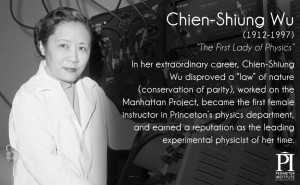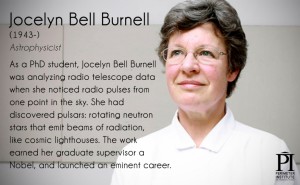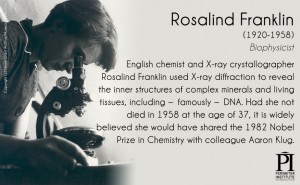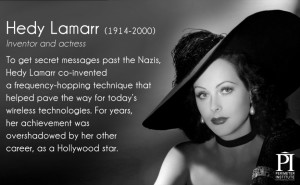In honour of International Women’s Day 2015, here are four items about women and science. The first features Canada’s Perimeter Institute (PI) and a tribute to pioneering women in physics, from a Feb. 26, 2015 PI news release,
They discovered pulsars, found the first evidence of dark matter, pioneered mathematics, radioactivity, nuclear fission, elasticity, and computer programming, and have even stopped light.
…
 It’s a fascinating group of women and these four provide a taste only.
It’s a fascinating group of women and these four provide a taste only.
The second item about women in science is also from the Perimeter Institute, which is hosting an ‘Inspiring Future Women in Science’ conference on Friday, May 6, 2015. From the PI program page,
Are you interested in turning your love of science into a career? Perimeter Institute is inviting female high school students to participate in an inspirational half day conference on Friday March 6, 2015. The goal is to bring together like minded young women with a strong interest in science and expose them to the rewards, challenges and possibilities of a career in science.
kEYNOTE ADDRESSES
Rima Brek – Rima is a Ubisoft veteran of 16 years and a founding team member of the Toronto studio. There, she was responsible for kick-starting the technology team and helping ship the critically-acclaimed Tom Clancy’s Splinter Cell Blacklist. She is a sought-after advisor whose guidance and leadership have directly helped Ubisoft Toronto grow to over 300 game developers in just five years.
…
Dianna Cowern – Dianna is a science communicator and educator. She received her degree in physics from MIT and completed a post-baccalaureate fellowship in astrophysics at Harvard. She then worked on mobile applications as a software engineer at General Electric before beginning a position at the University of California, San Diego as a physics outreach coordinator. She is the primary content creator for her educational YouTube channel, Physics Girl.
Roslyn Bern – As president of the Leacross Foundation, Roslyn Bern has been creating opportunities for women and girls throughout Canada. She has worked on initiatives for over 20 years, as an educator, a business woman, and as a philanthropist. She has focused on developing scholarships and bursaries for girls in under-represented career fields. She has been instrumental on sending teenage girls to the Arctic and Antarctic with Students on Ice, and created a partnership with colleges and corporations to certify STEM women in Electrical engineering. …
By the time this piece is posted it will be too late to attend this year’s event but interested parties could plan for next year in Waterloo, Ontario, Canada.
The third item concerns an initiative from the Public Radio Exchange, PRX. Called Transistor; a STEM [science, technology, engineering, and mathematics] audio project. From the series page,
Transistor is a transformative STEM podcast, taking the electricity of a story and channeling it to listeners. Three scientist hosts — a biologist, an astrophysicist, and a neuroscientist — report on conundrums, curiosities, and current events in and beyond their fields. Sprinkled among their episodes are the winners of the STEM Story Project, a competition we held for unique science radio.
Much as the transistor radio was a new technical leap, this Transistor features new women voices and sounds from new science producers.
PRX presents Transistor, applying our storytelling and podcast experience to science. The Sloan Foundation powers Transistor with funding and support. And listeners complete the circuit.
The Feb. 18, 2015 PRX news release offers more details about the hosts and their first podcasts,
PRX is thrilled to announce the launch of a new weekly podcast series Transistor (official press release). Three scientist hosts — a biologist, an astrophysicist, and a neuroscientist — report on conundrums, curiosities, and current events in and beyond their fields. Sprinkled among their episodes are the winners of the PRX STEM Story Project, a competition we held for unique science radio.
Just as the transistor radio was a new technical leap, this Transistor features new women voices and their science perspectives. We’ve launched with four episodes from our three scientist hosts:
- Dr. Michelle Thaller, an astrophysicist at NASA’s Goddard Space Flight Center, who studies binary stars and the life cycles of the stars.
- We Are Stardust: We’re closer than ever before to discovering if we’re not alone in the universe. Astrophysicist Michelle Thaller visits the NASA lab that discovered that comets contain some of the very same chemical elements that we contain. Then, Michelle talks to a Vatican planetary scientist about how science and religion can meet on the topic of life beyond Earth.
- Dr. Christina Agapakis, a biologist and writer based in Los Angeles. Her research focuses on the intersection of microbiology and design, exploring the symbiosis among microbes and biology, technology, and culture.
- Food, Meet Fungus: The microbiome — the trillions of bacteria, fungi, and viruses that live in and on our body — is hot right now. We explore what we do know in the face of so much hope and hype, starting with food.
- Dr. Wendy Suzuki, a Professor of Neural Science and Psychology in the Center for Neural Science at New York University, whose research focuses on understanding how our brains form and retain new long-term memories and the effects of aerobic exercise on memory. Her book Healthy Brain, Happy Life will be published by Harper Collins in the Spring of 2015.
- Totally Cerebral: Untangling the Mystery of Memory: Neuroscientist Wendy Suzuki introduces us to scientists who have uncovered some of the deepest secrets about our brains. She begins by talking with experimental psychologist Brenda Milner [interviewed in her office at McGill University, Montréal, Quebéc], who in the 1950s, completely changed our understanding of the parts of the brain important for forming new long-term memories.
- Totally Cerebral: The Man Without a Memory: Imagine never being able to form a new long term memory after the age of 27. Welcome to the life of the famous amnesic patient “HM”. Neuroscientist Suzanne Corkin studied HM for almost half a century, and gives us a glimpse of what daily life was like for him, and his tremendous contribution to our understanding of how our memories work.
Each scientist is working with a talented independent producer: Lauren Ober, Julie Burstein, and Kerry Donahue.
Subscribe to the show through iTunes or RSS, or you can stream it on PRX.org.
I listened to all four of the introductory programs which ranged in running time from about 16 mins. to 37 mins. All three hosts are obviously excited about sharing their science stories and I look forward to hearing more from them.
The last item comes from David Bruggeman’s Feb. 20, 2015 post on his Pasco Phronesis blog (Note: A link has been removed),
Science Goes to the Movies is a new program produced by the City University of New York and sponsored by the Alfred P. Sloan Foundation. … The hosts are Faith Salie, a journalist and host you might have heard before as a panelist on Wait Wait…Don’t Tell Me, and Dr. Heather Berlin, a neuroscientist whose research focuses on brain-body relationships and psychological disorders. (In what makes for a small world, Berlin is married to Canadian rap troubadour Baba Brinkman.) …
Science Goes to the Movies can be found here where you’ll also find a video of the first episode,
Hallucinations and black holes vie for the 2015 Oscar. Co-hosts Faith Salie and Dr. Heather Berlin are joined by AMNH astrophysicist Dr. Emily Rice for a look at the science in three of the top films of the year, Birdman, The Theory of Everything, and Interstellar.
Episode 102 featuring Into the Woods and the Imitation Game will première on March 20, 2015,
Science Goes to the Movies looks at The Imitation Game and Into the Woods. With special guest cryptologist Rosario Gennaro, we discuss pattern recognition in the work of both Alan Turing and Stephen Sondheim.
Science Goes to the Movies is made possible by generous support from the Alfred P. Sloan Foundation.
Kudos to the Alfred P. Sloan foundation for funding two exciting ventures: Transistors and Science Goes to the Movies.
Getting back to where I started: Happy International Women’s Day 2015!


